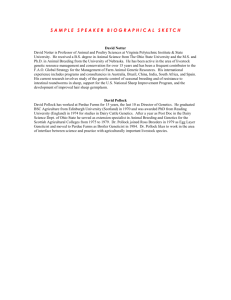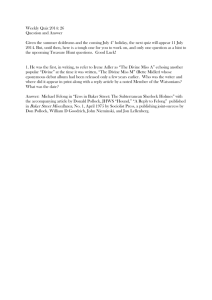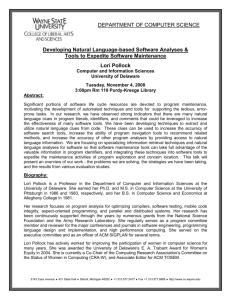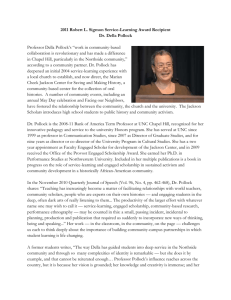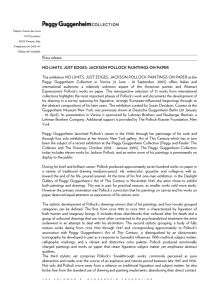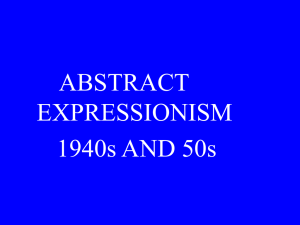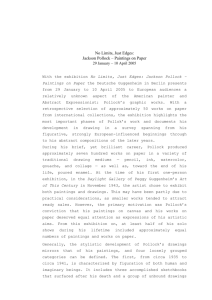MoMA Retrospective
advertisement
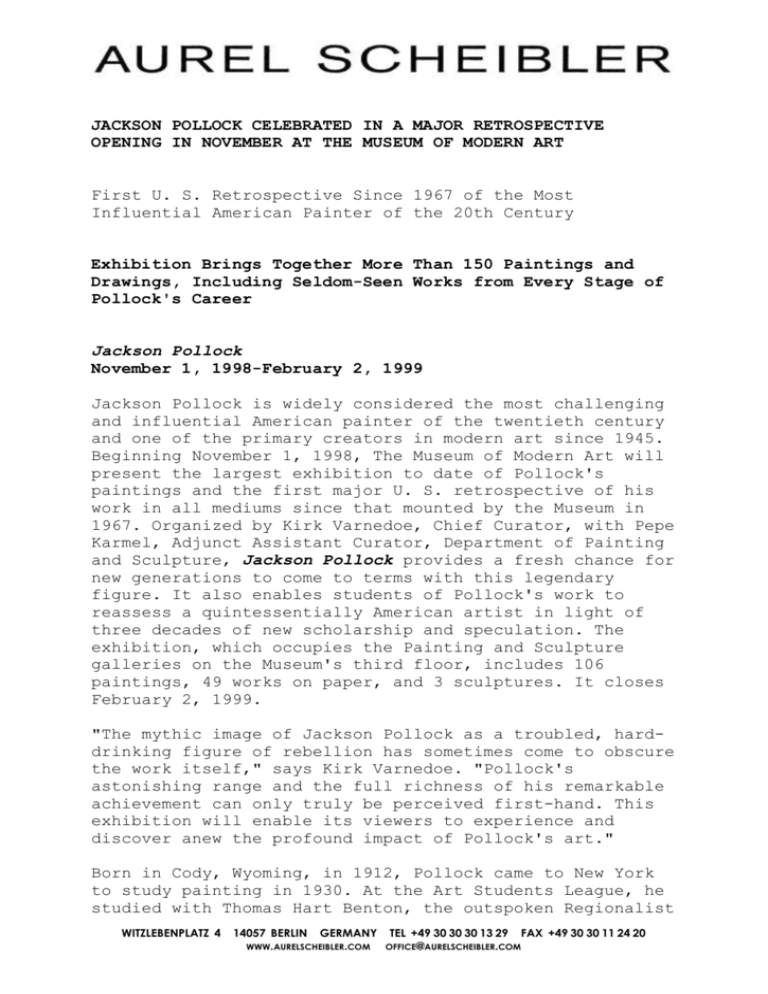
JACKSON POLLOCK CELEBRATED IN A MAJOR RETROSPECTIVE OPENING IN NOVEMBER AT THE MUSEUM OF MODERN ART First U. S. Retrospective Since 1967 of the Most Influential American Painter of the 20th Century Exhibition Brings Together More Than 150 Paintings and Drawings, Including Seldom-Seen Works from Every Stage of Pollock's Career Jackson Pollock November 1, 1998-February 2, 1999 Jackson Pollock is widely considered the most challenging and influential American painter of the twentieth century and one of the primary creators in modern art since 1945. Beginning November 1, 1998, The Museum of Modern Art will present the largest exhibition to date of Pollock's paintings and the first major U. S. retrospective of his work in all mediums since that mounted by the Museum in 1967. Organized by Kirk Varnedoe, Chief Curator, with Pepe Karmel, Adjunct Assistant Curator, Department of Painting and Sculpture, Jackson Pollock provides a fresh chance for new generations to come to terms with this legendary figure. It also enables students of Pollock's work to reassess a quintessentially American artist in light of three decades of new scholarship and speculation. The exhibition, which occupies the Painting and Sculpture galleries on the Museum's third floor, includes 106 paintings, 49 works on paper, and 3 sculptures. It closes February 2, 1999. "The mythic image of Jackson Pollock as a troubled, harddrinking figure of rebellion has sometimes come to obscure the work itself," says Kirk Varnedoe. "Pollock's astonishing range and the full richness of his remarkable achievement can only truly be perceived first-hand. This exhibition will enable its viewers to experience and discover anew the profound impact of Pollock's art." Born in Cody, Wyoming, in 1912, Pollock came to New York to study painting in 1930. At the Art Students League, he studied with Thomas Hart Benton, the outspoken Regionalist WITZLEBENPLATZ 4 14057 BERLIN GERMANY WWW.AURELSCHEIBLER.COM TEL +49 30 30 30 13 29 FAX +49 30 30 11 24 20 OFFICE@AURELSCHEIBLER.COM painter best known for his sprawling murals. He also worked briefly with Mexican muralist David Alfaro Siqueiros, and, in the late 1930s, fell in with artist and impresario John Graham. Despite stints with the Federal Art Project and a series of odd jobs, Pollock lived handto-mouth during the Depression years. At the same time, he struggled desperately with the alcoholism and emotional problems that would plague him throughout his life. By the early 1940s, Pollock had absorbed the powerful influence of Picasso, and begun attracting attention with his totemic images of figures and animals. It was at this time that he began showing at Peggy Guggenheim's Art of This Century gallery. Works from his first one-man exhibition, in 1943, such as Male and Female (c.1942), The She-Wolf (1943), and Guardians of the Secret (1943), among others, show Pollock painting with a violent intensity and experimenting simultaneously with a variety of styles and techniques. Pollock's career from the 1930s through the mid-1940s is represented by some 53 paintings and drawings in the first five galleries of the exhibition. One of the many highlights in these first rooms is the breakthrough painting Mural (1943), the first large-scale piece that Pollock completed. Commissioned by Peggy Guggenheim for her apartment, this dynamic work was reputedly painted in a single night. In 1945, Pollock married the painter Lee Krasner, whom he had met in 1941. In November of that year, Pollock and Krasner moved from Manhattan to The Springs, in East Hampton, Long Island. This relocation had a profound effect on Pollock's work. In a little more than a year, he completed two distinctive new series: the still-figurative Accabonac Creek series and the more fully abstract Sounds in the Grass series. Then, in 1947, he arrived at the revolutionary style of dripping and pouring that would make him famous. With their combination of all-over composition, gestural paint handling, and total abstraction, Pollock's classic works of 1947-50 announced the emergence of Abstract Expressionism. Dripping liquid paint directly from the can, or from a brush or stick held above the canvas, Pollock wove webs of interlacing lines, punctuated with puddles and spatters of color, creating images of stunning WITZLEBENPLATZ 4 14057 BERLIN GERMANY WWW.AURELSCHEIBLER.COM TEL +49 30 30 30 13 29 FAX +49 30 30 11 24 20 OFFICE@AURELSCHEIBLER.COM complexity. Roughly 46 of these works fill six exhibition galleries, culminating in the display of the three monumental paintings executed in the summer of 1950: Number 32, 1950; One: Number 31, 1950; and Autumn Rhythm: Number 30, 1950. Far from being uniform, these drip paintings evince an extraordinary range of moods, palettes, surfaces, and compositional decisions. To fully describe them, as Varnedoe writes in the exhibition catalogue, would require "perhaps as many words for 'line' as the Inuit legendarily have for 'snow.' " With these paintings, his advocates argued, Pollock demonstrated that American artists had at last equaled if not surpassed their European counterparts. As his peer and rival Willem de Kooning said, "Jackson broke the ice." Championed by art critics, notably Clement Greenberg, Pollock achieved an unprecedented degree of celebrity for a modern American painter. He was featured in Time, which coined the name "Jack the Dripper," and in a widely read Life magazine profile headlined "Is he the greatest living painter in the United States?" A striking photograph of a defiant, denim-clad Pollock accompanied the Life article. The combination of difficult, new work and cocksure attitude proved seductive, and Pollock's personality became fused with his paintings in the public imagination. This process was accelerated by the photographs Hans Namuth made in 1950 of Pollock at work in his Springs studio. Namuth took hundreds of shots from July until November, and made two films. No artist had ever looked like Pollock did in these photographs. His intense concentration and apparent spontaneity, as he seemed to perform a choreographed dance around the massive canvases, suggested a new way of making art; and the photos spread his influence even where the paintings had not been seen. Namuth's influential works are part of the exhibition. The films will be shown continuously, and a selection of the black-and-white photographs will hang in a full-scale recreation of Pollock's Springs studio, where they were taken. (The farmhouse and studio in The Springs still stand. They are preserved and are home to The PollockKrasner House and Study Center.) After 1950, Pollock once again confounded critics by reintroducing figurative images in his work, in a suite of WITZLEBENPLATZ 4 14057 BERLIN GERMANY WWW.AURELSCHEIBLER.COM TEL +49 30 30 30 13 29 FAX +49 30 30 11 24 20 OFFICE@AURELSCHEIBLER.COM controversial Black Paintings made for a 1951 show at Betty Parsons Gallery. Five of these works appear in the exhibition. While Pollock's reputation and celebrity grew exponentially around this time, his creative life slipped into serious decline. Through the mid-1950s, his drinking and emotional troubles escalated, and his relationship with Krasner became increasingly strained. In the summer of 1956, Krasner left for Europe without him. Driving drunk one night that August, Pollock lost control of his car, killing himself and one of the two young women who were his passengers. The last two galleries of the exhibition collect eleven of the best works from the last five years of Pollock's life, notably the exceptional Blue Poles (1952) and Portrait and a Dream (1953). Blue Poles, the last of the artist's monumental abstract paintings, returns to the United States for the first time since 1973, when it was purchased by the National Gallery of Australia. In bringing together in one place the full length and breadth of Pollock's career, the exhibition reveals the unfolding logic of his evolution from mythological themes to gestural abstraction, as well as the maturation of the discipline and mastery behind the apparent spontaneity of Pollock's work. Three galleries of Pollock's drawings and works on paper-taken from the late 1930s and early 40s, from 1944 to 1947, and from 1950 and 1951--illuminate lesser-known aspects of Pollock's oeuvre. In addition, there will be a concurrent show of Pollock's prints, Focus: Pollock and Printmaking, in the Paul J. Sachs Print Gallery on the Museum's third floor (see separate release). Pollock's prints are exceedingly rare and the Museum's permanent collection houses the most important known group, including singular proofs that were never editioned, as well as the copperplates on which the artist worked. This is the first time that a range of these printed works is on exhibition. A second print show, Dubuffet to de Kooning: Expressionist Prints from Europe and America (November 1, 1998-February 2, 1999), provides a contextual backdrop to Focus, while an exhibition of drawings, The New York School (September 17, 1998-January 12, 1999), surveys works on paper by Pollock and his peers. (See separate releases.) WITZLEBENPLATZ 4 14057 BERLIN GERMANY WWW.AURELSCHEIBLER.COM TEL +49 30 30 30 13 29 FAX +49 30 30 11 24 20 OFFICE@AURELSCHEIBLER.COM Jackson Pollock is made possible by Bank of America. Generous support is provided by The Henry Luce Foundation, Inc. The reconstruction of Pollock's studio is made possible by EXOR America (Agnelli Group). The Museum gratefully acknowledges the support of the Eugene V. and Clare E. Thaw Charitable Trust and an anonymous donor. Additional funding is provided by TDI. An indemnity for the exhibition has been granted by the Federal Council on the Arts and the Humanities. The accompanying catalogue is made possible through the generosity of The David Geffen Foundation. PUBLICATIONS Jackson Pollock by Kirk Varnedoe, with Pepe Karmel. Essays, selected bibliography, chronology. 425 illustrations, including 227 in full color, with 9 foldouts, 336 pages, 11 x 10". Clothbound, $75, distributed in the United States and Canada by Harry N. Abrams, and paperbound $35; both available in the MoMA Book Store. Jackson Pollock: A Symposium. Edited by Kirk Varnedoe and Pepe Karmel. A book of critical essays on Pollock's work by T. J. Clark, James Coddington, Pepe Karmel, Rosalind Krauss, Jeremy Lewison, Carol Mancusi-Ungaro, Robert Storr, Kirk Varnedoe, and Anne Wagner. Forthcoming in late 1999 or early 2000. TRAVEL The exhibition will travel to the Tate Gallery, London, from March 11 to June 6, 1999, under the auspices of The International Council of The Museum of Modern Art. ACCOUSTIGUIDE Kirk Varnedoe, Chief Curator, Department of Painting and Sculpture, narrates a 40minute audiotour of the exhibition, focusing on major works in the galleries. WITZLEBENPLATZ 4 14057 BERLIN GERMANY WWW.AURELSCHEIBLER.COM TEL +49 30 30 30 13 29 FAX +49 30 30 11 24 20 OFFICE@AURELSCHEIBLER.COM Audiotours are $4, members $3.50. PUBLIC PROGRAMS The Museum of Modern Art is planning several public programs in conjunction with Jackson Pollock. These unusual and varied programs will explore Pollock's life and work from several points of view: reminiscences by some of his surviving friends; assessments and appreciations by influential contemporary artists; analyses by curators, scholars, and critics; and a lecture by the exhibition's curator and catalogue author. For a complete schedule of events, please see separate public programs release. EDUCATIONAL BROCHURE A brochure will be available to visitors at the entrance of the exhibition. This publication, illustrated with reproductions of Pollock's paintings and photographs of Pollock by Hans Namuth, offers a succinct overview of his life and of his development as an artist. The text highlights specific works and identifies their location in the exhibition. The brochure was written by Kirk Varnedoe. FAMILY EXHIBITION GUIDE Parents and children are invited to explore the Pollock retrospective with the Family Exhibition Guide: Jackson Pollock. Developed for children ages five to twelve accompanied by an adult, the guide prompts families to look, question, and talk about what they see. It highlights six works, each accompanied by questions that are designed to help children develop visual observation skills. It is written by Joyce Raimondo, Family Programs Coordinator, and is available at the Lobby Information Desk and in the Edward John Noble Education Center. WEB SITE A subsite devoted to the exhibition will be available via the Museum Web site at www.moma.org, and adjacent to the exhibition galleries via touch screen kiosks. It will present information on Pollock's life and work, including specially prepared texts and representative artworks, and WITZLEBENPLATZ 4 14057 BERLIN GERMANY WWW.AURELSCHEIBLER.COM TEL +49 30 30 30 13 29 FAX +49 30 30 11 24 20 OFFICE@AURELSCHEIBLER.COM links to related programs and publications. The subsite will feature digitized film clips of Pollock at work, excerpted from footage shot by Hans Namuth; photocomposites assembled from Namuth's photographs, showing Pollock painting Autumn Rhythm (1950) and One, Number 31, 1950; and a rare audio clip of Pollock giving a radio interview in 1950. See separate release for details. VISITOR AND HOTEL PACKAGES A variety of special packages for individuals, families, and groups are being offered in conjunction with the exhibition, as are a number of special packages from New York hotels. See separate releases for details. JACKSON POLLOCK JAZZ CD Jackson Pollock thought jazz was "the only other really creative thing happening in this country." Indeed, his skeins of paint often seem like an inspired improvisation. In conjunction with the retrospective, the Museum is offering a compact disc of some of the artist's favorite jazz performances. This recording includes 17 jazz classics of the 1930s and 40s--from ragtime and blues through classical swing--selected from Pollock's personal collection of over a hundred 78s. See separate release for details. No. 76 ©1998 The Museum of Modern Art, New York WITZLEBENPLATZ 4 14057 BERLIN GERMANY WWW.AURELSCHEIBLER.COM TEL +49 30 30 30 13 29 FAX +49 30 30 11 24 20 OFFICE@AURELSCHEIBLER.COM
